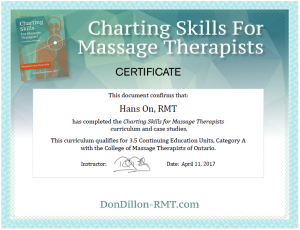Solid Charting: Strengthens Practice, Supports the Practitioner
 As a regulated health professional, solid charting is critical. Charting compares assessment to outcomes, focuses a treatment plan, adds value to your practice, and ensures compliance with regulations.
As a regulated health professional, solid charting is critical. Charting compares assessment to outcomes, focuses a treatment plan, adds value to your practice, and ensures compliance with regulations.
The charting methodology I learned was time-consuming and lacked effective outcome measures. I adopted a chiropractor’s example, but it lacked meaningful parameters to record soft-tissue dysfunction. Through trial and experimentation, I developed a methodology specific to massage therapists.
Whether you work in rehabilitation, spa, private practice, multi-disciplinary settings or workplace wellness sectors, this methodology transfers well to your situation. It even strengthens your electronic charting.
This program is for you if:
- You’re looking for a comprehensive way to document your massage therapy sessions
- You are required by your regulatory body to improve your charting method (or, you want to improve it BEFORE your records are audited)
- You want to reduce risk of harm, focus your assessment and conclusions, defend your treatment approach, record your measured outcomes and understand your patient’s progress
Included in the Charting Skills program:
- self-study manual (digital), complete with theoretical framework and pragmatic examples
- digital copies of the Intake (case history), Assessment and
 Treatment templates for you to download and incorporate in your practice
Treatment templates for you to download and incorporate in your practice - a handsome certificate when you successfully complete two case studies from the workbook
Review the first 2 chapters and the chapter index ChartSkills_Dillon.sample-Apr2017.
Continuing Education Units (CEUs)
Upon completion of the program, you can claim:
College of Massage Therapists of Newfoundland & Labrador – CMTNL – 3.5 CEUs, Cat B
College of Massage Therapists of New Brunswick – CMTNB – 3.5 CEUs, Cat A
Prince Edward Island Massage Therapy Association, PEIMTA – 7 CEUs, Cat A
Massage Therapists’ Association of Nova Scotia, MTANS, 3.5 CEUs, Primary
Massage Therapy Association of Manitoba, MTAM, 7 CEUs, Primary
Massage Therapist Association of Saskatchewan, MTAS – 4 CEUs, Cat Primary
Massage Therapist Association of Alberta, MTAA, 7 Primary Credits
*Note: the College of Massage Therapists of Ontario revised its quality assurance program in 2018 and no longer assigns CEUs.
Check your province’s regulatory body or professional association for additional consideration.
I’ve lectured to massage therapy associations across Canada, and Charting Skills is one of the topics most requested. Here are comments from your colleagues:
“I would recommend this workshop to new grads. I know it would have helped me tremendously when I was setting up my practice. It’s much easier to do things right from the beginning than to correct them later.”
“Don provided me with new ways of being efficient with documentation.”
“The downward spiral (of soft tissue dysfunction) explains why my weekly treatments over two years are not having lasting benefits.”
“Don is very knowledgeable about the topic and presents with humour. He is skilled at leading discussions & keeping on topic.”
The Charting Skills for Massage Therapists program is $79.95 + HST, and includes my review of your completed case studies and an electronic copy of your certificate of completion.
How this Program Supports You:
- Upgrade the Intake – A better case history yields focused and effective intervention.
- Lower risk of harm – Identify precautions and preclusions (yellow or red flags) in advance of any assessment or treatment you provide.
- Meaningful and Measurable – Incorporate up to seven outcome measures to demonstrate efficacious care.
- Quick and Easy – Document postural asymmetries, limited range-of-motion, perceived pain, and palpation findings simply and efficiently.
- Stay Out of Hot Water – Explore regulations and standards that apply to record-keeping so you remain compliant.
- Impress the Gatekeeper – Ask patients to share a copy of your completed Assessment record with their physician, nurse practitioner or physiotherapist. They’ll be impressed by what you screen for, measure and how your interventions reduce symptoms and resolve problems.

 Upgrade your Charting Skills to be more meaningful, measurable and compliant with regulations.
Upgrade your Charting Skills to be more meaningful, measurable and compliant with regulations.